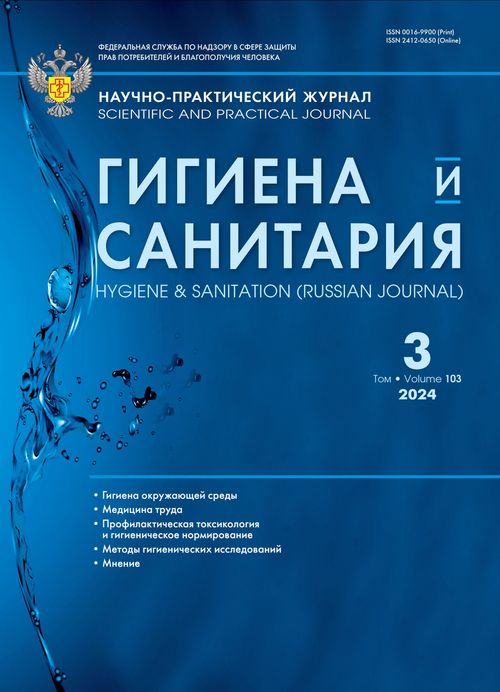On the issue of resolving disputes about the compliance of the research object with regulatory requirements
- Authors: Rahmanin Y.A.1, Rozental O.M.2
-
Affiliations:
- Centre for Strategic Planning of FMBA of Russia
- Institute of Water Problems of the Russian Academy of Sciences
- Issue: Vol 103, No 3 (2024)
- Pages: 223-226
- Section: ENVIRONMENTAL HYGIENE
- Published: 09.04.2024
- URL: https://jdigitaldiagnostics.com/0016-9900/article/view/638237
- DOI: https://doi.org/10.47470/0016-9900-2024-103-3-223-226
- EDN: https://elibrary.ru/gvopvt
- ID: 638237
Cite item
Full Text
Abstract
Conclusions on the fulfillment or violation of regulatory requirements ensuring the hygienic safety of the research object of the supervised object are carried out by state sanitary and epidemiological supervision bodies based on the results of laboratory studies of controlled indicators. These are, in particular, conclusions on the safety of drinking water sources for the population. The composition and properties of this water, on the instructions of sanitary and epidemiological supervision bodies and water supply institutions, can be examined equally by accredited laboratories that comply with the accreditation criteria in carrying out their activities. At the same time, unfortunately, it is impossible to guarantee the same results of laboratory testing of controlled microbiological, chemical, and other indicators, due to their variability and measurement errors. As a result, the conclusions about the quality and safety of water obtained by the supervisory authority and the supplier (user), primarily in cases concerning the boundary values of hygiene standards, may differ. For constructive resolution of controversial situations arising in this case, this paper proposes a method of tolerance control, the result of which is a logical judgment on the compliance or non-compliance of controlled quantities with established standards. It is shown how this reduces the risk of erroneous recognition of non-compliance of the composition or properties of water with hygienic requirements and guarantees safe water supply to the population. Authors suggested equations of admission control to assess compliance with the requirements of sanitary, epidemiological, and hygienic safety of controlled facilities. A method convenient for practical use is proposed, and using a specific example of monitoring the water quality of wells in the Talitsky district of the Sverdlovsk region, it is shown how it is possible to establish the water safety of almost half of the initially rejected water sources. The use of tolerance control is recommended if it is necessary to increase the reliability of hygienic conclusions on the safety of a wide range of supervised facilities, for which convenient mathematical expressions are given.
Contribution:
Rakhmanin Yu.A. — concept and design of the study, editing, approval of the final version of the article, responsibility for the integrity of all parts of the article;
Rozental O.M. — concept and design of the study, collection and processing of material, statistical processing, writing the text.
All authors are responsible for the integrity of all parts of the manuscript and approval of the manuscript final version.
Conflict of interest. The authors declare no conflict of interest.
Acknowledgement. The work was carried out within the framework of the state assignment of the Institute of Water Problems of the Russian Academy of Sciences (topic FMWZ-2022-0002).
Received: December 22, 2023 / Accepted: March 11, 2024 / Published: April 10, 2024
About the authors
Yurij A. Rahmanin
Centre for Strategic Planning of FMBA of Russia
Author for correspondence.
Email: noemail@neicon.ru
ORCID iD: 0000-0003-2067-8014
MD, PhD, DSci., Professor, Academician of the Russian Academy of Sciences, Chief Scientific Consultant of the Centre for Strategic Planning of FMBA of Russia, Moscow, 119121, Russian Federation
Russian FederationOleg M. Rozental
Institute of Water Problems of the Russian Academy of Sciences
Email: orosental@rambler.ru
ORCID iD: 0000-0001-6261-6060
MD, PhD, DSci., Professor, Chief Researcher, Institute of Water Problems of the Russian Academy of Sciences, Moscow, 119333, Russian Federation
e-mail: orosental@rambler.ru
Russian FederationReferences
- Rakhmanin Yu.A., Rozental’ O.M. Improvement of water quality control to guarantee qualifying health and hygiene requirements. Gigiena i Sanitaria (Hygiene and Sanitation, Russian journal). 2019; 98(2): 203–4. https://doi.org/10.18821/0016-9900-2019-98-2-203-204 https://elibrary.ru/yznaup (in Russian)
- Sopin V.F., Maksimova E.E. Control and management of the risk of obtaining unreliable test laboratory results. Vestnik tekhnologicheskogo universiteta. 2017; 20(12): 104–6. https://elibrary.ru/ytnqtx (in Russian)
- Kuselman I. Validation of test methods, human errors and measurement uncertainty of results. Chem. Int. 2017; 39(2): 40–2. https://doi.org/10.1515/ci-2017-0231
- Karpov Yu.A., Filippov M.N., Baranovskaya V.B. Solved and unsolved problems of metrology of chemical analysis. Zhurnal analiticheskoy khimii. 2019; 74(9): 839–46. https://doi.org/10.1134/S1061934819090053 https://elibrary.ru/erfvpz
- Tziakou E., Fragkaki A.G., Platis A.Ν. Identifying risk management challenges in laboratories. Accred. Qual. Assur. 2023; 28: 167–79. https://doi.org/10.1007/s00769-023-01540-3
- Nozdrachev A.F., ed. Conflict of Interests in the State and Municipal Service, in Entities Activity: Causes, Prevention and Reconciliation [Konflikt interesov na gosudarstvennoy i munitsipal’noy sluzhbe, v deyatel’nosti organizatsiy: prichiny, predotvrashchenie, uregulirovanie]. Moscow: INFRA-M; 2016. https://doi.org/10.12737/18874 https://elibrary.ru/vuntul (in Russian)
- Lebedev A.M. Investigation of the reliability of admission control. Nauchnyy vestnik Moskovskogo gosudarstvennogo tekhnicheskogo universiteta grazhdanskoy aviatsii. 2005; (86): 65–70. https://elibrary.ru/kgdcux (in Russian)
- Ghazzawi H.A. Feedback admission control for workflow management systems: Diss. York; 2015.
- Krutikov N., Glukhov Yu., Ivanov V. Risks associated with measurement errors. Kontrol’ kachestva produktsii. 2021; (10): 8–16. https://elibrary.ru/knogdy (in Russian)
- Santana M.K.A., Loureiro G. Risk management approach for testing and calibration laboratories. Accred. Qual. Assur. 2022; 27: 313–8. https://doi.org/10.1007/s00769-022-01521-y
Supplementary files









